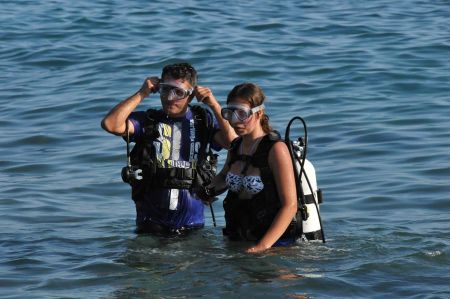Diving - What picturesque surroundings!
The rough rock drops down vertically into the depths. The stones seem to shine. Like the flowers of the dandelion, huge amounts of long-tentacled plate corals grow on the rocks. Starfishes of orange and red are everywhere.
Without any great movement of their flippers, the divers get deeper and enjoy the quickly, always-changing impressions, metre by metre.
Their depth gauges show the 40 metre mark when a big cave opens out on the sea bed. Seconds later the divers move into a different, strange world. In the half-light of "Coral Cave" it seems like big elephants' ears made from chalk hang from the ceiling, colonies of plants abound, while thousands of shrimps hurry between the rocks. An octopus hides itself behind some rocks. Because of the lights from the divers it is disturbed and not happy anymore.
Diving sites like this one at the seaside resort of Kas are not uncommon on the southern coast of Turkey. Where one sandy beach follows another, there is a huge variety of different sights under water: canyons, caves and rocks alternate with sandy places or green places covered with seaweed. Sometimes you can see up to 40 metres. Diving through the night from the pebble beach of Kücük Cacil, diving to the wreck of a wooden boat or sliding through the Canyon will never be forgotten by sports divers. There is also the top diving spot of Assi Island. There you will find a huge field of amphoras where you can look but not touch anything on the seabed. This place is good for experienced divers due to its depth of 37 metres.
But diving sites of up to only 18 metres in depth are available at the Turkish beaches, for example, near Fethiye, Dalaman or Kalkan.
On the Turkish Riviera, between Kemer and Antalya, you will find a big cave, the wreck of the MS Didier and the amphora cliff. Wherever you find something with a historical background or from ancient times you should keep always remember: Sightseeing yes, touching no!
As well as the variety of different diving spots available, the variety of diving schools is as wide. Nearly all seaside resorts offer one or two diving centres, mainly down by the harbour. Between Izmir and Antalya some of the holiday hotels have their own water-sports centres. After diving, holidaymakers can choose: If they do not want to go diving again after a short break, other sports like tennis or golf, rafting or sailing and lots of other possibilities are available.
.
Have you ever dreamed of being able to dive?
Here in Alanya, there are also several chances for you to experience the weightlessness of being below the water. The most interesting spots for diving are next to the harbour and at the Castle Mountain. The big advantage in Turkey is that in one day you can take diving trips to many different places. A beautiful world of plants, the huge variety of different fish, and especially the caves, have made Alanya well-known place for diving.
Also, diving is not as difficult as it might seem at first. It can be great fun, especially with a professional instructor. Experts from the diving organisation WTO think that, over the next few years, the number of tourists taking yachting holidays will increase rapidly and a high number of them will choose to come to Turkey. Therefore, they expect the number of tourists coming for diving to increase as well.
In Alanya there are three diving schools already which have well-trained and government approved instructors. The underwater world around the castle is amazing, with its many different types of fish, so shimmering and colourful. No wonder that there already is a huge range of different diving courses on offer. There are even courses for children from the age of twelve. Elderly people, if they do not have serious health problems, can also take part in this sport, although many schools will ask for an ECG, just to check there are no heart problems.
A tip: If you are coming to Turkey for diving, ask your doctor whether there may be a problem and have an updated ECG with you.
Now, enjoy the picturesque waters around the castle.
